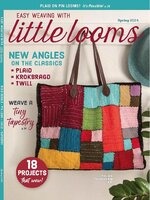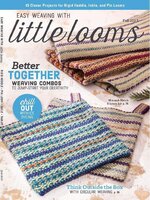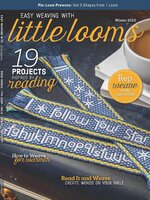Easy Weaving with Little Looms is a perennial favorite. By popular demand, it will now be available by subscription. Each issue will have the mix of 18–22 projects, techniques, and features you love, expanding the focus on fundamental weaving skills, creative inspiration, and innovative applications. Each issue is designed to have something for beginning and more experienced weavers. In addition to the core subjects of rigid-heddle and pin-loom weaving, Little Looms regularly includes projects and articles about tapestry, tablet weaving, and inkle weaving.
Little Looms
EDITORIAL
TARTAN
FANCY FINDINGS • Treat your stash to a new chunky cotton perfect for rigid-heddle weaving, and then treat yourself to a brand new loom or a miniaturized version of one of your favorite looms.
ADORABLE BEASTS • 30 PIN LOOM ANIMALS + 4 PLAYSCAPES
ADORABLE BEASTS EXCERPT: SLOTH
THE BEAT GOES ON • Maintaining a consistent beat is a challenge for most weavers early in their weaving lives, but I can attest as a 30-year veteran that the beat (struggle) goes on.
WEAVING SQUARED • It’s hip to be square with this selection of weaving looms and tools.
WEAVE TOGETHER WITH HANDWOVEN RETREAT • Join the fun, build community with other small-loom weavers, and surround yourself with weaving at Long Thread Media’s inaugural Weave Together with Handwoven retreat. The four-day event is an all-inclusive retreat where students can relax, take workshops, and build friendships while somebody else takes care of the looms, hotel, meals, and entertainment.
PIN-LOOM PLAIDS AND CHECKS • When we hear the term plaid, tartans come to mind, followed by Scottish kilts, bagpipes, and wondrous clan stories. However, at the core of all plaids and checks is the idea of intersecting horizontal and vertical stripes of varying colors, typically forming a grid or checkered design, and that goes far beyond tartan patterns.
TAPESTRY WEAVING: WEAVING IN OPPOSITE DIRECTIONS • Tapestry weaving is a quintessentially slow craft. Every pass must be thoughtful, each technique chosen carefully, and all colors well contemplated. Even learning to weave tapestry is a slow process. Over many years of teaching, we’ve learned to discourage students from taking on too much too soon. Your first tapestry will not be perfect. Your selvedges will not be straight. You will not successfully jump headfirst into double-weft interlock or other complicated techniques unless you first learn the basics—the building blocks—the simple techniques that take time to perfect. The word tapestry is often used as a metaphor for life, and it fits in so many ways: from the importance of unweaving when you’ve made a mistake to the need to hone your skills slowly and carefully.
CELTIC SQUARE BABY BLANKET • Simple squares and rectangles become more than the sum of their parts in these spectacular projects.
MODULAR BLOCK RUNNER
TUMBLING BLOCKS BLANKET
FASHION PLAID WRAP
A QUILTER'S SCARF
CELTIC SQUARE BABY BLANKET
MODULAR BLOCK RUNNER
TUMBLING BLOCKS BLANKET
FASHION PLAID WRAP
A QUILTER'S SCARF
SUNSHINE ON YOUR SHOULDERS • Weave these projects with a touch (or more) of yellow to add a little sunshine to your home and wardrobe.
SPRING FORWARD TOWELS
BLOOMS ON BLUE RUNNER
TABLETOP POP
ESCHER PLACEMATS
PIN-LOOM PATCHWORK BAG
SUNSHINE ON YOUR SHOULDERS
SPRING FORWARD TOWELS
BLOOMS ON BLUE RUNNER
TABLETOP POP
ESCHER PLACEMATS
PIN-LOOM PATCHWORK BAG
CHECKERS TO GO • Combine your love of weaving with your love of games in these three playful projects.
NOUGHTS AND CROSSES
ROYAL CHESSBOARD
CHECKERS TO GO
NOUGHTS AND...

 Spring 2025
Spring 2025
 Winter 2024
Winter 2024
 Fall 2024
Fall 2024
 Summer 2024
Summer 2024
 Spring 2024
Spring 2024
 Winter 2023
Winter 2023
 Fall 2023
Fall 2023
 Summer 2023
Summer 2023
 Spring 2023
Spring 2023
 Winter 2022
Winter 2022
 Fall 2022
Fall 2022
 Summer 2022
Summer 2022
 Spring 2022
Spring 2022
 Holiday 2021
Holiday 2021
 Summer 2021
Summer 2021
